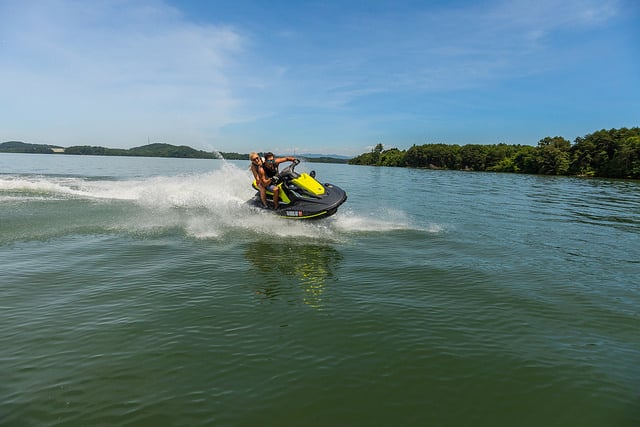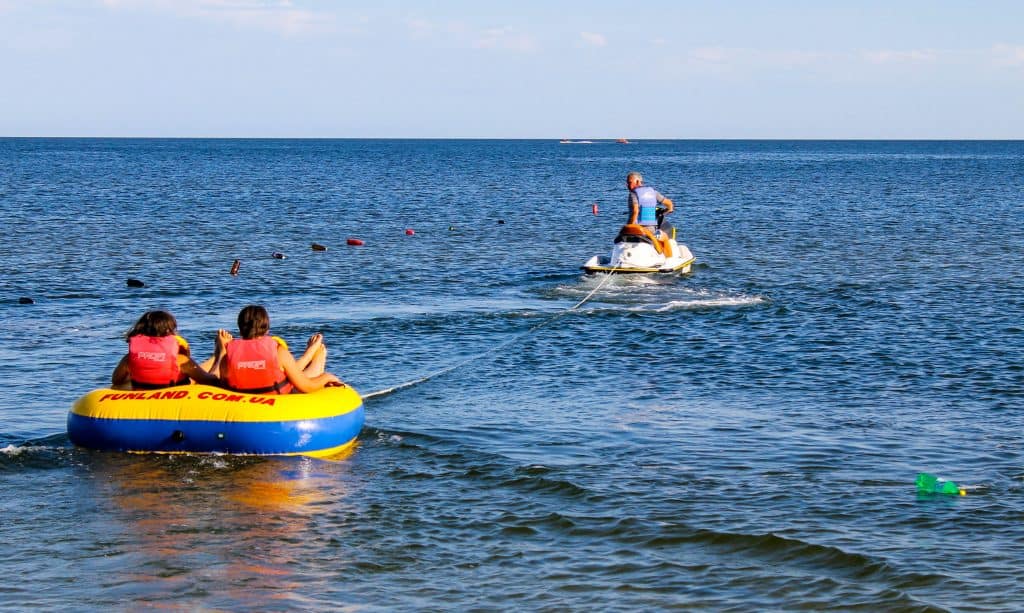
Where did the jet ski come from? Who created it? All of your questions on the history of jet skis can be answered below!
The American born Clayton Jacobson II invented jet skis in 1973. The first successful internal pump-jet personal watercraft was a stand-up Kawasaki they called the “Jet Ski.”
Clayton Jacobson’s Idea
Clayton Jacobson II was born in Multnomah County Hospital in Portland, Oregon October 12, 1933. In the ’40s his family moved to Southern California. Aside from his studies on physics and engineering, Jacobson spent his time street racing, bodybuilding, and working in an auto garage.
After college at Los Angeles City College, he joined the Marine Corps Reserve to work close with jets. A few years later he married Dianne and they had four children. After quitting the food business he was in, he began working with his father-in-law. He then became involved with Motorcross racing.
This led to his idea of the jet ski when he was done crashing onto the pavement during his motorcycle races. After a crash, he started to sketch a diagram of the “motorcycle for the water.” He quit his job and spent all of his time working on his dream of the motorcycle on water.
By 1965 he created his first prototype. This specific watercraft was made out of aluminum and was powered by a two-stroke engine. The next year, his second prototype was complete.
He went to Bombardier to get them to buy his jet ski, but they did not see a future with it. He then went to Kawasaki, which was just known for motorcycles.
They took a chance on him and in 1973, they released the first production stand-up Jet Ski. Jacobson eventually licensed with the top three known brands for jet skis; Bombardier for the Sea-Doo, Kawasaki for the Jet Ski, and the Yamaha Waverunner.
Elements of the Jet Ski
You may wonder what is going on inside a jet ski and how it works.
- There is water being sucked in through an intake grate on the bottom of the craft
- The power is provided by a gasoline engine which is fired by electric ignition. There is usually a 2-stroke engine or a 4-stroke engine in a jet ski.
- In a PWC, the engine powers the water pump and the impeller (a propeller inside a pipe so it can suck water in at one end and out the other end). The impeller has 3 blades made of stainless steel. A little bit of the water that is sucked in cools the engine down so it does not overheat.
- The way water speed is built up is the water exiting through a steerable nozzle that is smaller than the water intake near the back of the jet ski.
- The handlebars you use to turn the jet ski pull on a cable that moves the water jet one way, making the whole watercraft turn.
Types of Jet Skis
- Recreation- These are the most bought jet skis and they are very agile on the water. These are average size, have good storage space, and have a top speed of 99 km/h (about 60 mph)
- Tow Sports- These are for families that like to pull a water skier or wakeboarder behind. There are limited options in this category including the Sea-Doo Wake 155 and the Sea-Doo Wake Pro 230. The good news about these is their resale value is good.
- Luxury- Best for people looking for more comfort and horsepower. They are more expensive but travel at speeds up to 105 km/h (66 mph).
- Performance- The jet ski racers usually look into these ones. In just 3 seconds the engine can reach 130 km/h (80 mph)!
- Rec-Lite- Newer category for those who are looking for the cheapest kind of jet ski. Only available through Sea-Doo and Yamaha. Top speed is 80 km/hr (50 mph) and is recommended for beginners.
The First Personal Watercraft Brands

The three most popular jet ski brands as you have probably heard are Kawasaki, Sea-Doo, and Yamaha. What are the differences between these brands’ jet skis?
Sea-Doo
Sea-Doo is a brand manufactured by Bombardier Recreational Products or BRP. In 1968 the first BRP personal watercraft was created and they called it the Sea-Doo. Clayton Jacobson II was the designer.
This was powered by a 320cc engine with a top speed of 25 mph. This engine overheated too quickly and was soon replaced in 1969 by a water-cooled (instead of air cooled) 367cc engine.
Sea-Doo became its own brand in 1988 and it became more popular throughout the ’90s. The biggest advantage of Sea-Doo’s products is the pricing. The base models of Sea-Doo’s do not have upgrades which is why they are so affordable. Once you do upgrade, it becomes about as expensive as the Yamaha jet ski.
If you are looking for a specific feature on your jet ski for things like pulling, this is the only brand you have. Since Sea-Doo is an innovator, they make specific jet skis for the people’s needs.
Yamaha
In 1986 Yamaha released the WaveRunner 500 which was the world’s first sit-down jet ski. This is also called the Marine Jet 500T as it was made for the militia who traveled on sea. This is the exact model that created the foundation for today’s PWC market.
Just 4 years later, the WaveRunner III 650 or Marine Jet 650TL was invented. This was the first 3-passenger PWC on earth and with fantastic running performance. Another first on this was the reverse drive included.
Yamaha’s engines are where their strength is at. These engines not only last forever, but perform really well. If you like to change your own oil and do your own maintanence, then Yamaha is for you because these are more simple to work on then Sea-Doo or Kawasaki.
Even though they are a little more expensive than Sea-Doo, by being able to work on the jet ski yourself you will save a lot of money instead of having to take it in and get it serviced. Yamaha is known for its incredible fuel efficiency which is very convenient when it comes to money and riding time!
Families with children are recommended to get a Yamaha because of the extra safety precautions they take. Their jet skis can turn without accelerating and they have excellent brakes that stop the watercraft smoothly.
Kawasaki
Kawasaki is a company with a rich history beginning in the late 1800s. Kawasaki originally started as a shipping company and evolved greatly after that to making planes, helicopters, machinery, bridges, cars, motorcycles and finally, in 1973 they released the first jet ski.
Preceding the release of the jetski, the company organized a marine products team in 1971 in an attempt to expand their consumer base. Their first jet ski engine was even actually based off of a snowmobile engine!
There was an extremely positive reaction to the release of the Jet Ski and so the company began mass production. Within a few years their product was worldwide.
It’s pretty obvious that Kawasaki has made their name in the Personal Watercraft industry. Today their brand is one of the most expensive, but if you are looking for speed and style then Kawasaki is the way to go.
The Kawasaki “Jet Ski” will forever be known. Even if is actually a Yamaha, or a Sea-Doo, everyone who has limited PWC knowledge will call them a Jet Ski.
Facts About the Jet Ski
- Personal watercraft do not harm seagrass beds. Jet skis also do not create huge water turbulence either.
- Personal watercraft manufacturers have invested more than $1,000,000,000 in technological advances to help with protecting the environment.
- Today’s jet skis have 75% fewer emissions than 1998 models.
- Jet skis are 70% quieter than the 1998 models.
- Direct injection which is the technology used today has reduced emissions by 75%.
- More than 280 personal watercraft were donated in Florida to state and local law enforcement officials.
- Since the boating education law was passed in Florida in 1980, accidents have decreased by 22%.
